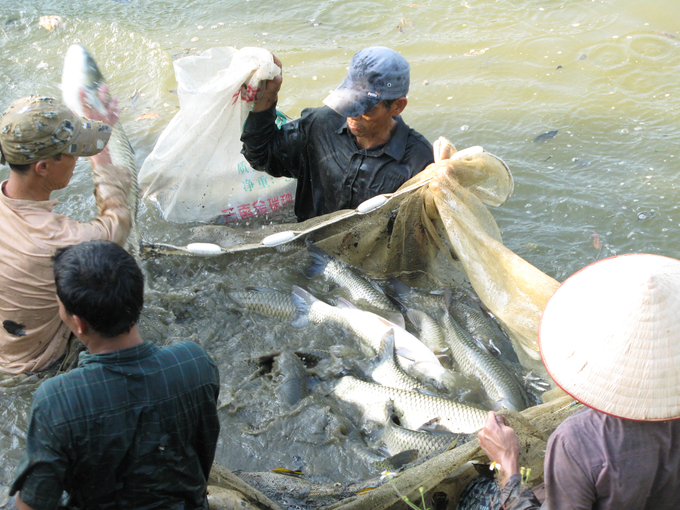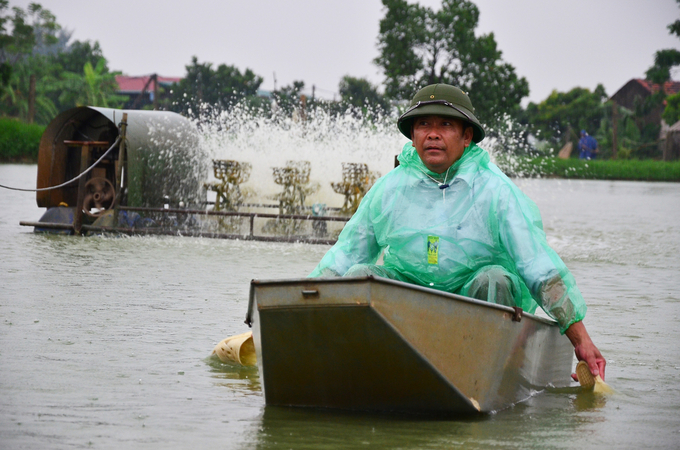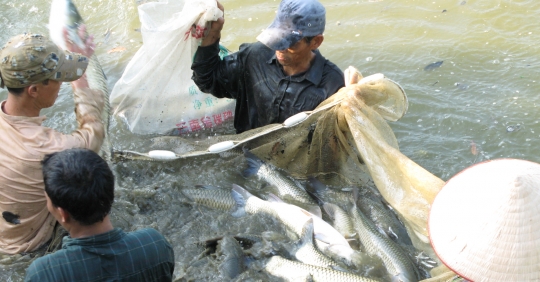From the land of “contemplation, lazy season” to a large water area
Mr. Le then explained
Nowadays, the price of fish is over VND50,000/kg, the price of food has dropped a bit, so the profit is quite good, the pond owners are very excited. The fish price could not make up for last year’s value and fell to only 40,000 VND/kg, so that nobody could laugh.
If farming is done with the right techniques and an average yield of 25 tons of fish per hectare per year and each ton is sold for 50 million dongs, the total turnover is also 1.25 billion dongs, of which the profit is 15-20%, which is about 200 million dongs.
Households with a large pond area like Mr. Le Xuan Huu (3 ha), Vu Ba Hoc (3 ha), Nguyen Manh Tuong (2 ha), Dinh Quang Linh (2 ha)…really made a big profit.

Mr. Le Xuan Huu, Director of Tram Long Fisheries Cooperative with VietGAP certificate. Picture: Van Dinh.
Ung Hoa district has more than 10,000 hectares of agricultural land with many very low-lying areas, especially in the Chay region.
To ensure the success of aquaculture in the district today, the work of the pioneering and dynamic farmers who switched to the rice-fish model must first be mentioned. After that, the government must promote and support policies.
The entire district currently has 4,070 hectares of aquaculture, which is mainly concentrated in communities such as Tram Long, Minh Duc, Trung Tu, Phuong Tu and Hoa Lam. And the cradle of aquaculture of the capital is the Municipality of Tram Long, where about 450 hectares of water surface are planted with many species of fish.
Few people would have thought that just over 10 years ago, the rows of ponds that followed each other day and night, the oxygen fans were just paddy fields, which were always in a precarious situation of “contemplation, lazy season”, so the ground was very low and difficult to drain. In the meantime, the cooperatives could not play their role in controlling production, could not organize services for their members and gradually found themselves in the situation of being forced to dissolve.
Currently, since some households have switched from rice cultivation to fish farming, the income is much higher, which is why the municipality and district authorities have planned Tram Long as an aquaculture area.
Mr. Le’s wish is to unite farmers who cultivate themselves, have very low self-consumption, have no voice in society, and are represented by an organization like a cooperative.
Initially the cooperative had 25 members and then gradually grew to around 40 members with a total pond area of 60 hectares, of which over 20 hectares have been recognized as conforming to VietGAP standards. Currently, the municipality of Tram Long is taking another step forward in their profession and plans to develop a common seal of approval for the fish.

Fishing in the suburbs of Hanoi. Picture: Data.
The main species of fish farmed here are traditional species such as grass carp, common carp, sesame carp and drift carp. They are arranged to cleverly use the habitat of each species according to the bottom, middle and surface layers of the pond. In addition, catfish and driftfish are also responsible for cleaning up the waste or leftovers from carp and fish and cleaning the water.
According to Mr. Huu, seasonal epidemics have been common in the past. Carp fishing was common during the Tet period, carp fishing was common in July and August. Nowadays, agriculture is concentrated, diseases are common, so attention must always be paid to water treatment.
Diseases must be prevented by probiotics and disinfection with biological products. In addition, it is necessary to regularly change the water and run the aerator, on the one hand to provide oxygen for the work and growth of fish, and on the other hand to ensure oxygen for the aerobic organism to balance the living environment in the pond.
“Recently we brought in fish samples for testing. The result is that there are no antibiotic residues and the nutrient content of the fish meat is very sufficient,” said Mr. Huu. Unfortunately, despite complying with VietGAP standards, the cooperative’s products cannot be sold at a higher price than usual.
The secret of fishing success
I inquired about feeding the fish by giving orders on the phone for a while, and Mr. Le
Whatever you say, it still has to be done directly by human hands, because fish farming too has to be done like children. Are there children who can feed with a machine? During the feeding process, the pond owner must directly observe the fish’s abnormal expression in order to make a timely treatment plan. If there is a small mistake, hundreds of millions will be lost instantly.”
When asked what factors determine success in fish farming, Mr. Huu replied, “Human is the most important factor in this profession.” Farmers must know the technique of juvenile selection, know how to manage the aquatic environment, know how to feed…and at the same time, they must love the work. The rainier and windier the nights are, the more often I have to be outside the pond, but I cannot eat and sleep well.”

Despite the rain and wind, Mr. Le Xuan Huu – director of the Tram Long Fisheries Cooperative – still had to visit fish regularly. Picture: Van Dinh.
At the end of the fish farming story, I asked about the cooperative: why is it profitable to do business as an individual, but he excels as a director who runs the collective? He replied, “It is also about the bamboo tree leaning on the bamboo. I have spent several billion dongs as capital for the cooperative to provide aqua feed for its members for mutual benefit. Cooperative owners get quality bran at a lower price than buying from outside agents, and I also get the same profit as a top-notch bran agent when I’m a human service provider.
In terms of production, our cooperative can supply 5-7 tons of fresh fish every day, but no company has consumed it yet, but we still only sell to private traders. My wish is not only to sell fresh fish, but also to be supported by the state to build and invest in fish processing zones and cold storage so that I can actively supply goods to supermarkets and community kitchens in Hanoi and other provinces.”
Several “river-in-the-pond” farming models are also being developed in the Tram Long community, with yields three to four times higher than conventional farming.
Mr. Dinh Quang Linh’s family in a Thai village has invested in the construction of two such river-in-a-ponds. Each tank is 2m deep, 5m wide and 25m long and can accommodate 2,000 to 3,000 carp.
This model makes it easier for him to monitor and control the disease and allows for higher stocking densities due to the current, which brings more oxygen to the fish.
In addition, the model also actively helps him collect and treat waste according to many agricultural crops, since special pumps create “small rivers” that continuously flow in the pond and collect waste, which settles in the tank and is cleaned by the vacuum cleaner every day.
There is no excess feed to cause water rot, so fish have fewer diseases and gain weight quickly. Regular swimming against the current will help tighten the flesh. Another advantage of the “river-in-the-pond” model is that new bedding can be raised after harvest without having to till the soil.
At present, there are over 400 fish farms in Tram Long Municipality, with a water area of 448 hectares. Compared to the rice monoculture in the past, the efficiency of aquaculture is three to four times higher, reaching 500-600 million VND/ha/year, the profit can be about 200 million VND/ha/year.

